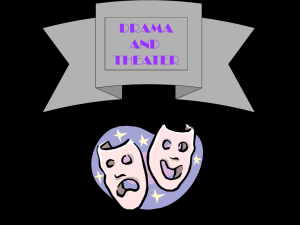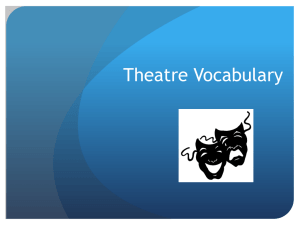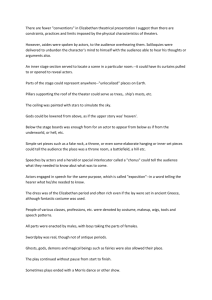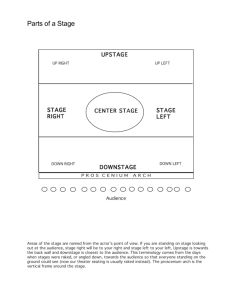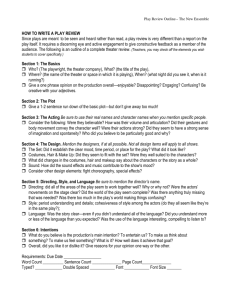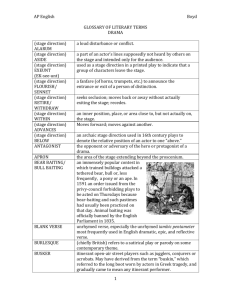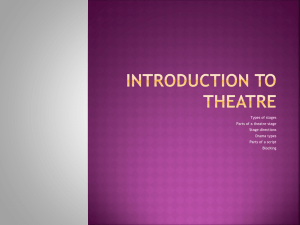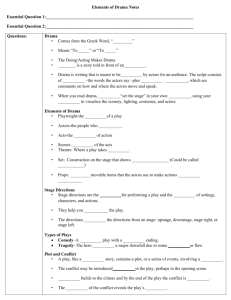http://teacher
advertisement
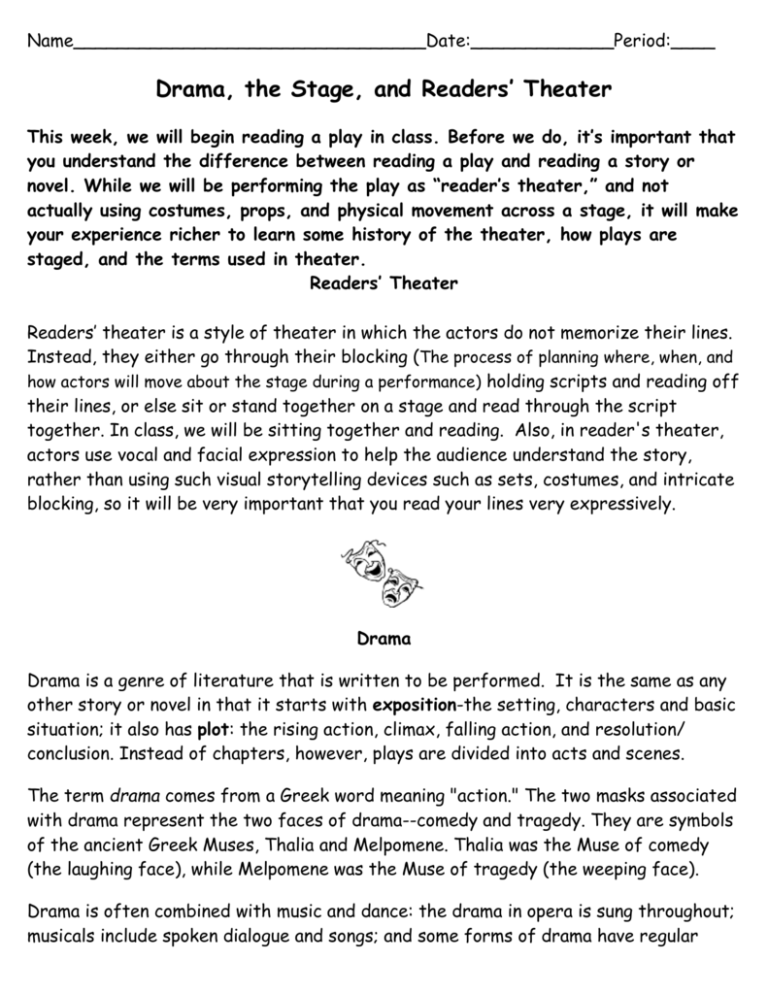
Name________________________________Date:_____________Period:____ Drama, the Stage, and Readers’ Theater This week, we will begin reading a play in class. Before we do, it’s important that you understand the difference between reading a play and reading a story or novel. While we will be performing the play as “reader’s theater,” and not actually using costumes, props, and physical movement across a stage, it will make your experience richer to learn some history of the theater, how plays are staged, and the terms used in theater. Readers’ Theater Readers’ theater is a style of theater in which the actors do not memorize their lines. Instead, they either go through their blocking (The process of planning where, when, and how actors will move about the stage during a performance) holding scripts and reading off their lines, or else sit or stand together on a stage and read through the script together. In class, we will be sitting together and reading. Also, in reader's theater, actors use vocal and facial expression to help the audience understand the story, rather than using such visual storytelling devices such as sets, costumes, and intricate blocking, so it will be very important that you read your lines very expressively. Drama Drama is a genre of literature that is written to be performed. It is the same as any other story or novel in that it starts with exposition-the setting, characters and basic situation; it also has plot: the rising action, climax, falling action, and resolution/ conclusion. Instead of chapters, however, plays are divided into acts and scenes. The term drama comes from a Greek word meaning "action." The two masks associated with drama represent the two faces of drama--comedy and tragedy. They are symbols of the ancient Greek Muses, Thalia and Melpomene. Thalia was the Muse of comedy (the laughing face), while Melpomene was the Muse of tragedy (the weeping face). Drama is often combined with music and dance: the drama in opera is sung throughout; musicals include spoken dialogue and songs; and some forms of drama have regular musical accompaniment. In improvisation, the drama does not have a script, instead, performers create their own lines on the spot in front of an audience. The Stage In theater, the stage is a space for the performance of theatrical productions. The stage serves as a space for actors, singers and dancers to perform, and as a focal point for the members of the audience. The stage may consist of a platform (usually raised) or series of platforms. In some cases, these may be temporary or adjustable but in theaters and other buildings devoted to such productions, the stage is usually a permanent feature. Types of Stages: There are four types of stages. They differ in use how the audience is seated. The Proscenium Stage The most common form found in the West is the proscenium stage. Ernie Davis Middle School’s auditorium has a proscenium stage. The word “proscenium” comes from the Greek for “in front of the scenery.” In this type of stage layout, the audience is located in front of the stage with the remaining sides of the stage hidden and used by the performers and technicians. The primary feature is a large arch, the proscenium arch, through which the audience views the performance. The audience directly faces the stage--which is typically raised several feet above front row audience level--and views only one side of the scene. This one side is commonly known as the invisible fourth wall of the scene. When an actor “breaks the fourth wall,” he or she is speaking directly to the audience. Normally actors perform as if no audience exists. When this “fourth wall” is broken in movies or television, the actor will talk directly to the camera. This can be used for comic effect or in some cases for narration or explanation. The first indoor theatres were created in French tennis courts and Italian Renaissance palaces. Stage floors were raked (slanted) upward slightly from front to back, in order to make groups of actors more visible to audiences who were at first seated on a flat floor. The Raked Stage Side view of a “raked stage” The stage itself has been given named areas to allow the precise movement and positioning of actors on a stage. To an actor facing the audience, "left" and "right" are the reverse of what they are for the audience. To prevent confusion, actors and directors never use the unmarked terms left or right for the sides of the stage. Rather, they use a phrase specifying the viewpoint. When you read a play and hear the terms “exit stage right,” or “enter stage left”, the terms "stage left" and "stage right," denote the sides of the stage that are on the actor's left and right when the actor is facing the audience, while "house left" and "house right" are the reverse, denoting the sides of the stage as viewed by the audience. Likewise, the meaning of "front" and "back" would be unclear because they depend on perspective. Instead, the term "upstage" is used to mean the part of the stage furthest from the audience or to motion away from the audience, while "downstage" denotes the portion of the stage closest to the audience or to motion in that direction. These terms were common in older theaters due to the raking (slant) of the actual stage deck. So upstage was actually a higher level than downstage. Later, audience seating was raked instead of the stage, and balconies were added to give audiences a fuller view. By the end of the 19th century most stages had level floors, and much of the audience looked down on, rather than up to, the stage. During the early years of indoor theater, the competition among royals to produce elegant and elaborate entertainments caused huge amounts of money to be spent on the creation of European court theaters. The proscenium arch, often extremely decorative and often covered in gold leaf, "framed" the stage set. The desire of court painters to show more than one of their perspective backgrounds led court architects to adapt the rigging and pulleys used on ships for raising and lowering their sails to the lowering and raising of elaborately painted canvas backdrops. This system required the creation of a storage loft usually as high, or higher than, the proscenium itself. Originally the scenery was raised and lowered by the strength of stage hands. Today there is complicated machinery that uses cables and motors to do the heavy lifting. The proscenium also hides the sides of the stage, called the wings, which may be used by theater personnel working on the particular performance as well as a space for storage of scenery and theatrical props. Often, a stage may extend in front of the proscenium arch which offers additional playing area to the actors. This area is a referred to as the apron. Underneath and in front of the apron is sometimes an orchestra pit which is used by musicians during musicals and operas. The orchestra pit is often sunken into the floor in front of the stage and may sometimes be covered and used as an additional playing space in order to bring the actors closer to the audience. The Thrust Stage Thrust stages may be similar to proscenium stages but with a platform or performance area that extends into the audience space so that the audience is located on three sides of the actors. Theater in the Round Stage Theater in the round, as shown above, consists of a stage situated in the center of the theater, with the audience facing it from all sides. This type of stage may be specifically constructed like the one shown above, or may simply be a group of actors performing in the middle of a crowd, such as at a street fair or carnival. The audience is placed quite close to the action which provokes a feeling of intimacy and involvement. Created and Found Stages A Ugandan woman performs on a “found” stage; an area of cleared dirt around which an audience sits. The fourth type of stage, created or found stages are simply places that can be improvised where ever a suitable space can be found. Examples may include staging a performance in a non-traditional space such as the basement of a building, the side of a hill or, an open field, or, in the case of street performers, as mentioned above, in the middle of a road. Stagecraft Stagecraft is a term referring to the technical aspects of theatrical, film, and video production. It includes, but is not limited to: Lighting: Lighting design, which involves the process of determining the size, intensity, shape, and color of light for a given scene. Hanging, focusing, procurement and maintenance of lighting and special effects equipment, aspects of show control Make-up/Wigs: The application of makeup and wigs to accentuate an actor's features. Mechanics: Design, engineering and operation of flown scenery or flying of performers and mechanized scenic elements and special effects. Production, comprising stage management, production management, show control/direction, house management and company management Scenery, which includes set construction, scenic painting, soft goods (drapes and stage curtains), and special effects. Sound, which can include musical underscoring, vocal and instrument mixing as well as theatrical sound effects. Theatrical property, or “props,” which includes furnishings, set dressings, and all items large and small which cannot be classified as scenery, electrics or wardrobe. Props handled by actors are known as hand props, and props which are kept in an actor's costume are known as personal props. Wardrobe: costume design, construction, and purchasing In small acting companies, stagecraft is often managed by a single person (often the stage manager) who arranges all scenery, costumes, lighting, and sound, and organizes the cast. At a more professional level, for example, in modern Broadway houses in New York, stagecraft is managed by hundreds of skilled carpenters, painters, electricians, stagehands, sewers, wigmakers, and the like. Now that you have learned about drama and the theater, keep these ideas in mind when you are asked to read a part in a play. Even though you will not be “trodding the boards” as stage actors call their craft, you will be able to use your imagination to remind yourself that acting is about being fully involved in the character you are portraying. Some people think they will be laughed at if they “act,” read with emotion, and use accents or voices, but the opposite is true. It is much more embarrassing to read in a monotone, flat voice and have no facial expression. So, as actors say, “Break a leg!” Go for it, and enjoy! Name: ____________________________________________Date:______________Period:______ Use the handout Drama, the Stage, and Readers Theater to answer the following questions. Short Answer: 1. Explain why directors use the stage directions “upstage” and “downstage.”___________________ _________________________________________________________________________________ _________________________________________________________________________________ _________________________________________________________________________________ 2. What are the two ways that reader’s theater actors have of portraying their characters? _________________________________________________________________________________ _________________________________________________________________________________ 3. What are the four types of stages mentioned in the handout? ______________________________ _________________________________________________________________________________ _________________________________________________________________________________ 4. “Breaking the fourth wall” means:___________________________________________________ _________________________________________________________________________________ 5. Explain at least two things that are hidden by the proscenium arch:_________________________ _________________________________________________________________________________ _________________________________________________________________________________ _________________________________________________________________________________ 6. What type of stage would be best-suited to performances where audience participation and interaction with the actors is desired? Explain your answer._________________________________ _________________________________________________________________________________ _________________________________________________________________________________ _________________________________________________________________________________ 7. What other mechanical devices led to the creation of the complicated system of pulleys cables created over stages? _________________________________________________________________________________ _________________________________________________________________________________ ________________________________________________________________________________ Fill in the Blanks: 8. Stages often have areas called _____________________ where the pulleys that raise and lower scenery are hidden. 9. The _________________________is an area that extends past the proscenium that gives actors more room to perform. 10.The easiest type of stage to make is a ____________________ or ________________stage because it doesn’t require any construction or even building. 11. The sides of the stage where things are stored and actors hide while waiting to come on stage are called the ____________________________. 12. In a stage play, the placement and movement of actors is called:_______________________. 13. Making up a play or skit at the moment it is performed is called:_______________________. 14.The Greek muse of comedy was Thalia, represented by a _________________________ and the Greek muse of tragedy was Melpomene, represented by a__________________________. 15.Today audiences sit in raked seats, which means the seats are _________________________. 16._________________________________is a term that refers to all the technical, production aspects relating to drama. 17.Being fully ______________________________ in your character is essential to being a good actor.
